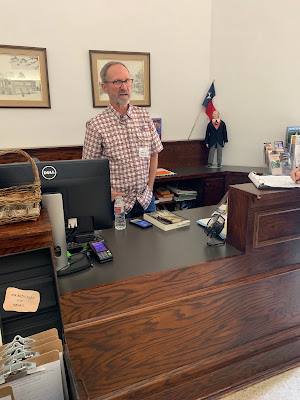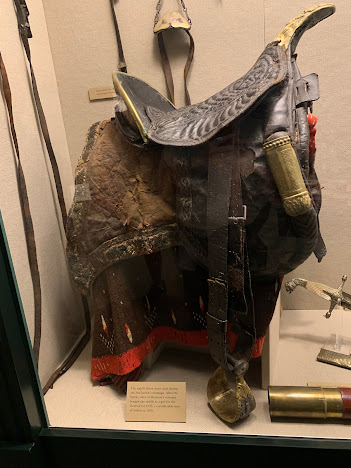In the course of our travels we've encountered Huntsville, Alabama - but who knew there was also a Huntsville, Texas? After we learned that Sam Houston was buried there (yes, we like visiting cemeteries), we set out to see the cemetery since it was only about an hour from where we were staying.
Right before reaching the city, there is a HUGE statue of Sam Houston along the highway. So, of course, we pulled off and into the Visitor Center.
A Tribute to Courage
Sam Houston is one of the founding fathers of Texas. He led the army of Texas during their War of Independence from Mexico in 1836, including the victory at San Jacinto (more on this later) where Texas won Independence by defeating Mexican President Santa Anna in the field.
The statue was built in 1994. At 67 feet tall, it is the ninth tallest statue in the United States.
We went into the Visitor Center and came across the 'mascot' on the way.
When the Governor of Texas Sam Houston refused to take an oath to the Confederacy on March 16, 1861, he was removed from the governor's office. Booed by crowds and driven from state politics, Houston settled into a self-imposed exile in Huntsville. He watched in dismay as Texas joined the Confederacy. He died two years later, a lonesome and broken man.
The Sam Houston Monument was executed in San Antonio from the sculptor's plaster cast. The inscriptions were composed by Sam Houston's youngest daughter and approved by other family members. When the monument was delivered for the 1911 ceremonies, it was found that the word "governor" had been misspelled. The only correction that could be made quickly was to smooth the area and abbreviate the word as "gov'nor."
In 1999, the Huntsville community put together a time capsule depicting what life was like before the coming new millennium. It was placed inside the statue's right leg and will be opened in the year 2099 to showcase the difference in 100 years. Bet I won't be here to see it. :-)
It was on to Oakwood Cemetery which was originally a 1,600-square foot plot that was deeded to the city of Huntsville in 1847 by the founder of Huntsville, Pleasant Gray. It existed as early as 1846 and its oldest section predates the founding of the city. It is comprised of six sections: the Old Cemetery; the African American cemetery; the New Cemetery, which was expanded in both 1887 and 1910; the Addickes Addition, which was added in 1925 and is where Sam Houston's beloved Steamboat House (more later) was originally located before being moved; the Mayes Addition, which is the newest section and is the only section with plots open for new burials; and the Wildwood Sanctuary, which is a bird sanctuary.
For once, it was easy to find Sam Houston's burial site as it is right next to a parking lot so parking is easy....and no walking :-)
THE WORLD WILL TAKE CARE OF HOUSTON'S FAME
Andrew Jackson
Now this is a nice monument!
As we drove out, we learned that not only was Sam Houston University nearby but also the Sam Houston Memorial Museum was next door to the university. So off we went.
We were the only people there except for volunteer, Bruce. We spent quite a bit of time with him and he pointed out some of the more historic artifacts in the museum
This was a bible given to Sam Houston's son, Sam, with the inscription "From his Mother, March 6, 1862."
On the morning of April 6, Sam, Jr. and the Confederates launched a massive surprise attack on the Union lines. During the assault, a mini ball pierced his knapsack and this small Bible. Cutting through the pages the ball stopped on the 70th Psalm with the line "O God: though art my help and my deliverer."
The saddle Santa Anna used during the San Jacinto campaign. After the battle, some of Houston's veterans bought the saddle as a gift for the General for $325, a considerable amount of money in 1836.
Sam Houston wore this vest proudly as a gift from his brothers the Cherokee Indians. Although it is made from a jaguar, Sam enjoyed telling friends, and especially his enemies, that he wore this leopard vest because "A leopard never changes its' spots."
I think this may have been one of the most peculiar exhibits on display.
Sam Houston used this crutch, made of Texas Bois d'Arc, to get around after his ankle was wounded at the Battle of San Jacinto.
There were so many things it was overwhelming and we still wanted to see the houses and gift shop in the back of the museum so we took a walk.
It seems that many visitor centers and gift shops have a mascot. But this was the first time I'd seen a rooster!
Blondie
The Steamboat House was built in 1858 by Dr. Rufus Bailey, President of Austin College from 1858-1862, as a wedding gift for his son. The unusual house caused such joking, however, the couple refused to live in it. In 1862, after Sam Houston left the governorship of Texas, he rented Steamboat House, and here he died in 1863. His funeral was held in the upstairs parlor. In 1933, Houston businessman J.E. Josey bought the house and gave it to the State of Texas. The Centennial Commission restored the building and moved it here from the cemetery grounds in 1936.
They had it furnished nicely and it was interesting to see what it might have looked like at the time Sam Houston lived (and died) here.
Bed that Sam Houston died in
Dining Room
After Sam Houston's death, Union prisoners, overseen by a carpenter, fashioned a coffin for their newfound friend, and in the early morning they carried it up the hill to the Steamboat House. Houston's body, dressed in a black suit and a Masonic apron, was placed inside.
A few mourners gathered at four in the afternoon the day following his death in the upstairs parlor of the Steamboat House. A heavy rain was falling. His wife's Baptist pastor was away, so Houston was buried by a minister from the denomination of his childhood, Presbyterian.
The small cortege left the house and followed the Masonic pallbearers down the steep flight of steps and through the mud to the neighboring cemetery. The graveside service was brief and when concluded, his wife and children returned to Steamboat House.
Upstairs parlor
Phew, we'd built up quite an appetite so we went downtown to get some lunch. Bruce had recommended a historic place so we went there and had some further discoveries. More on that in the next post.





















No comments:
Post a Comment